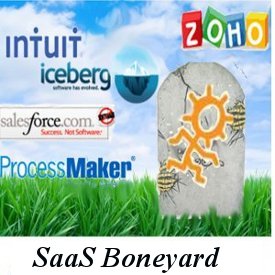 TechCrunch just recently reported the demise of Coghead, one of the Web’s most popular SaaS enterprise solutions. Coghead suggested via this article, that the economic downturn is to blame for its woes. There is however a more basic and realistic flaw for many such developments. The longest running argument against any SaaS platform has been data backup and security, and this is detrimental in any economic situation.
TechCrunch just recently reported the demise of Coghead, one of the Web’s most popular SaaS enterprise solutions. Coghead suggested via this article, that the economic downturn is to blame for its woes. There is however a more basic and realistic flaw for many such developments. The longest running argument against any SaaS platform has been data backup and security, and this is detrimental in any economic situation.
In a recent article by Larry Dignan of ZDNet, both data backup and economic aspects of SaaS are brought into question. Though the economic downturn may be a concern for SaaS, as is data backup, another element has been overlooked. Raw data, no matter how it is “banked” (as Dignan points out) is literally useless without an application to run it. In this one respect alone, developers of Web based business SaaS have made a crucial error. No business, however small, can afford even the remote possibility that their data gets stuck in limbo.
Why some of these developers never made a “stand alone” version, including proper documentation, is a mystery. My expertise in this space consists of testing some of these services early on (Coghead in particular), and working with Iceberg, helping with their new site design and release news. The viability of Iceberg and Process Maker are particularly relevant for this argument in that they do have “on site” services.
The chart below illustrates a comparative of several SaaS services including; Coghead, Zoho, Process Maker, QuickBase, SalesForce and Iceberg.

Redundancy For Viability
However much we all want SaaS to be successful, viability effects everyone from developers to end users – business or individuals. Time is money, as they say, so losing data or even having it “detained” is not an option for most. Coghead’s ultimate fate as a technology is uncertain, in today’s news that SAP acquired it. Irregardless, redundancy with regard to both application and data would seem prudent for SAP now.
Final Notes
Coghead as a Web 2.0 (or whatever) development is significant. I reached Wayne Byrne, Co-founder of Iceberg, to get his thoughts on this news. Even given his development’s somewhat unfair comparisons early on to Coghead, his statement reveals a lot about Coghead as an innovation:
Coghead simplified and communicated the message of SaaS, webware in a way that none of the other players were able to, and captured peoples imaginations.
I also asked Byrne about backup for SalesForce, given their massive acceptance. Byrne replied: “Salesforce’s customers can request backup, but it is given in the form of Excel spreadsheet, and it would take companies months to sort all this out.” Also, my original contention about “useless raw data”, seems valid too. Every development in this space has its strengths and weaknesses, but at the core of an SaaS company, data security has to be at the top of lists. Suggesting viability without this “guarantee” seems ludicrous.
Author’s Note & Disclosure: As I mentioned in the body of this article, I consulted with Iceberg for website design, PR and SEO early in its development. Any opinion expressed or implied is not intended to be an advocacy of one product over another, and is certainly not the suggestion of SitePoint or its community. I suggest that the Web community as a whole, evaluate these services more completely. In so doing, we can more easily guarantee the art of the development and the end users are not left wondering what happened.
Update: Intuit contacted me via their PR and suggested that workflow, Excel integration and other features are available. I include the work flow (though there still is no visual work flow), and Excel as givens. As for API suggested utility, an open API doesn’t mean you can upload your own code to the app. They also wanted to know what data base integration was. This allows one platform to get data directly from another data base, which seems indispensable given that Coghead’s users need someone to integrate their data now.
Frequently Asked Questions (FAQs) about Coghead
What was Coghead’s primary function?
Coghead was a web-based service platform that allowed users to create and manage custom online databases for their businesses. It was designed to simplify the process of creating web-based applications. Users could design their applications using a visual, drag-and-drop interface, eliminating the need for extensive coding knowledge.
Who were the founders of Coghead?
Coghead was founded by Paul McNamara and Greg Olsen. They aimed to provide a platform that would democratize the process of creating web-based applications, making it accessible to non-technical users.
When was Coghead founded and when did it cease operations?
Coghead was founded in 2003 and it ceased operations in 2009. The company was unable to sustain its business model, leading to its eventual closure.
What was unique about Coghead’s platform?
Coghead’s platform was unique because it was one of the first to offer a completely web-based, drag-and-drop interface for creating custom online databases. This made it possible for non-technical users to create and manage their own web applications.
Who acquired Coghead and why?
Coghead was acquired by SAP, a German multinational software corporation. SAP was interested in Coghead’s technology and its potential to enhance their own cloud-based services.
What happened to Coghead’s customers after the acquisition?
After the acquisition, SAP provided a migration path for Coghead’s customers to move their applications to the SAP platform. This ensured that customers could continue to use and manage their applications without significant disruption.
What were some of the challenges faced by Coghead?
Coghead faced several challenges, including competition from other similar platforms, the complexity of creating a user-friendly yet powerful interface, and the difficulty of maintaining a sustainable business model.
How did Coghead impact the software industry?
Coghead was one of the pioneers in the field of web-based application development. Its innovative platform influenced the development of similar services and contributed to the growth of the cloud-based software industry.
What were some of the features of Coghead’s platform?
Coghead’s platform offered a range of features, including a visual, drag-and-drop interface, customizable templates, and the ability to create complex workflows. It also provided robust security features and the ability to integrate with other web services.
Can I still use Coghead’s platform today?
No, Coghead’s platform is no longer available for use. After the acquisition by SAP, the platform was integrated into SAP’s own services. However, there are many other similar platforms available today that offer comparable features and capabilities.
Published in
·APIs·CMS & Frameworks·Database·Frameworks·Laravel·Libraries·PHP·Web Services·February 29, 2016

Published in
·Design Patterns·Patterns & Practices·Performance·Performance & Scaling·PHP·Security·August 21, 2017




